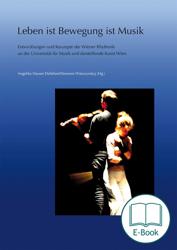The book shows how the connections of music and movement
can be taken up to convey social and creative skills - not only to children but also to adults, elderly people and people with special needs.
After a short introduction into the development of the Vienna faculty the interrelations of music and movement will be explained in more detail by means of the different aspects of Rhythmics/Music and Movement. At the end the applications of the method to the major target groups are described and an insight into the didactics of the subject is provided.
What does music and movement have to do with our being humans? Basic musicality and basic patterns of movement are given to all of us. Without these qualities we would not be able to learn languages and to understand each other. What from the start functions unconsciously can be stimulated and supported through artistic means. Artistic expression is part of human nature and not a luxury. Especially through music and movement we can develop further the foundations of communication and enhance our awareness of life.
The present book shows how the connections between music and movement can be taken up in education to convey social and creative skills - not only to children but also to adults, elderly people and people with special needs.
After a short introduction into the development of the Vienna faculty the interrelations of music and movement will be explained in more detail by means of the different aspects of MB/R. At the end the applications of the method to the major target groups are described and an insight into the didactics of the subject is provided.
13 authors who teach at the department of Music and Movement Education/Rhythmics at the University of Music and Performing Arts Vienna and who are shaping the field of study in an decisive way describe and justify important results and insights from their longtime experience as professionals and teachers in artistic, pedagogic and/or scientific fields. In 18 contributions they exhibit the different aspects of Music and Movement Education/Rhythmics. As a whole they offer an overview of the potential and the manifold possibilities of the department.
„Der bemerkenswerte Sammelband mit Beiträgen von zwölf Lehrenden der Wiener Rhythmikausbildung bereichert die Diskussion rund um Musik und Bewegung innerhalb der Musikpädagogik auf vielfältige Weise. Einerseits als Dokumentation der 57 Jahre alten Ausbildung gedacht, bietet das Werk andererseits eine aktuelle Darstellung vieler relevanter Fragestellungen bezüglich Zielen, Methoden und Arbeitsfeldern der Rhythmik. Die Leserschaft ist heute auch nicht mehr auf RhythmikerInnen im engeren Sinne beschränkt, sondern umfasst PädagogInnen der Elementaren Musikpädagogik und der Elementaren Musik- und Tanzpädagogik in der Tradition des Orff-Schulwerks. [...] Besonders hervorzuheben sind die sehr gute Lesbarkeit aller Beiträge, die mit vielen Praxisbeispielen durchsetzt sind.“
Von: Manuela Widmer
In: üben & musizieren 4/2017, S. 49.
--------------------------------------
„Die ,Wiener Rhythmik’ blickt auf eine lange und bedeutende Geschichte zurück. Dieses Werk ist für Interessierte Fundgrube und Schatzkiste zugleich!“
Von: o.A.
In: Unsere Kinder. Das Fachjournal für Bildung und Betreuung in der frühen Kindheit, 2 (2017), S. 25.
Hauser-Dellefant Angelika, Dipl.
Rhythmikstudium an der Hochschule für Musik und Theater Hannover; Studium des Bewegungstheaters bei Lecoq u. a. in Paris; Ausbildung in der Franklin-Methode. Weiterbildungen in den Bereichen Musik, Bewegung, Pschotherapie und Teamleitung.
Seit 1982 Lehrende an der mdw, seit 2002 Leiterin des Institutes MBM; 1992 – 2005 Lehrende an der Anton Bruckner Universität Linz. Choreographin, Darstellerin, Trainerin, künstlerische Leiterin von Projekten; Kurs- und Vortragstätigkeit im In- und Ausland; Autorin von Fachbeiträgen.
hauser@mdw.ac.at (Auf folgender Seite gibt es weitere Infos zur Vita:
https://www.mdw.ac.at/I113/html/mbe//?PageId=3517)
Witoszynskyj Eleonore, Mag.a phil.
Studien: Rhythmik in Zürich und Wien, Instrumentalpädagogik an der mdw sowie Pädagogische Psychologie und Sonderpädagogik an der Universität Wien; Tanztherapie/Bewegungsanalyse.
Nach langjähriger Lehrtätigkeit als Professorin, derzeit Lehrauftrag an der Abteilung MBP/Rhythmik an der mdw. Gastvorträge, Seminare und Workshops bei Internationalen Symposien und an Hochschulen im In- und Ausland; Publikationen u. a.: Bankl, I./Mayr, M./Witoszynskyj, E.: Lebendiges Lernen durch Musik, Bewegung, Sprache. (2009).
witoszynskyj@teleweb.at


 Table of Contents
Table of Contents